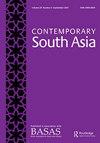Anjuman, jami‘at, and association: what Sayyid organizations tell us about associational forms among Muslim caste groups
IF 0.8
3区 社会学
Q3 AREA STUDIES
引用次数: 0
Abstract
ABSTRACT In the early decades of the twentieth century in colonial India, the development of education, the expansion of electoral politics, and the decennial censuses led many caste communities, or ‘caste groups’, to organize collectively in search of internal solidarity and public assertion. Informed by the notions of service and reform, Muslims participated in this new associationism. Among them, the Sayyids – a privileged status group that claims descent from Prophet Muhammad – also formed their organizations. This article compares three Sayyid organizations in India and Pakistan, with two principal aims. First, it brings out the implicit notions of inclusion and exclusion that inform the functioning of the organizations as they seek community preservation. Second, it draws broader conclusions about associational forms available to South Asian Muslims when they act collectively on the basis of a shared social status or caste. The article concludes by delineating three ‘organizational models’ that Muslim caste groups can draw upon – the anjuman, the jami‘at, and the association. Overall, this article illustrates how Muslims frame practices of social distinction in an Islamic language of equality, piety, or service.Anjuman, jami 'at和协会:赛义德组织告诉我们穆斯林种姓群体之间的协会形式
在二十世纪早期的殖民印度,教育的发展、选举政治的扩大和十年一次的人口普查导致许多种姓社区或“种姓团体”集体组织起来,寻求内部团结和公开主张。受服务和改革观念的影响,穆斯林参与了这种新的联合主义。其中,赛义德人——一个声称是先知穆罕默德后裔的特权群体——也成立了自己的组织。本文比较了印度和巴基斯坦的三个赛义德组织,主要有两个目的。首先,它提出了包含和排除的隐含概念,这些概念在组织寻求社区保护时告知其功能。其次,当南亚穆斯林在共同的社会地位或种姓基础上集体行动时,它得出了更广泛的结论。文章最后描述了穆斯林种姓群体可以借鉴的三种“组织模式”——anjuman、jami’at和协会。总的来说,这篇文章说明了穆斯林是如何在平等、虔诚或服务的伊斯兰语言中构建社会区别的实践的。
本文章由计算机程序翻译,如有差异,请以英文原文为准。
求助全文
约1分钟内获得全文
求助全文
来源期刊

Contemporary South Asia
AREA STUDIES-
CiteScore
2.10
自引率
0.00%
发文量
82
期刊介绍:
The countries of South Asia - Bangladesh, Bhutan, India, Maldives, Nepal, Pakistan and Sri Lanka - are internally diverse and part of global flows of people, goods and ideas. Contemporary South Asia seeks to address the issues of the region by presenting research and analysis which is both cross-regional and multi-disciplinary. The journal encourages the development of new perspectives on the study of South Asia from across the arts and social sciences disciplines. We also welcome contributions to pan-regional and inter-disciplinary analysis. Our aim is to create a vibrant research space to explore the multidimensional issues of concern to scholars working on South Asia and South Asian diasporas in the postcolonial era.
 求助内容:
求助内容: 应助结果提醒方式:
应助结果提醒方式:


